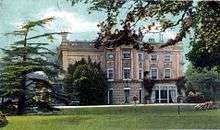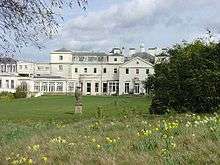William Manning (British politician)
William Manning (1 December 1763 – 17 April 1835) was a British merchant, politician, and Governor of the Bank of England.[1]

Manning was the son of West India merchant William Coventry Manning and Elizabeth Ryan.[2] Manning's sister Martha married American Revolutionary War patriot John Laurens.[3] Manning joined his father's firm, taking control after his father's death in 1791.
He worked as a merchant in the West Indies, acting as agent for St Vincent (1792-1806) and for Grenada (1825-1831). He was elected a Director of the Bank of England from 1792 to 1831 and its Governor between 1812 and 1814, having served as its Deputy Governor from 1810 to 1812. He also invested in the Australian Agricultural Company, becoming its Deputy Governor in 1826, and was president of the London Life Assurance from 1817 to 1830.[4]
He inherited Copped Hall, Totteridge, Hertfordshire, where his wife Mary Hunter re-designed the grounds, probably with the advice of Humphry Repton, damming the Folly Brook to create the ornamental Darland's Lake.[5]
Between 1794 and 1830 he served almost continuously as a Member of Parliament in turn for Evesham, Lymington and Penryn.[1]

After the death of Lord Frederick Campbell in 1816, he bought Combe Bank near Sevenoaks, Kent from Campbell's daughter. However he got into financial difficulties in the 1820s and had to declare himself bankrupt in 1831. He was forced to resign from the Bank of England, sell his estates and move to a smaller property in Gower Street, London.
He died at Gower Street in 1835 and was buried at Sundridge, Kent. He had married twice; firstly Elizabeth, daughter of banker Abel Smith of Nottingham, with whom he had 2 daughters and secondly Mary, daughter of barrister Henry Lannoy Hunter of Beech Hill, Reading, Berkshire with whom he had 4 sons and 4 daughters.
One son, Henry Manning,[6] was ordained as an Anglican clergyman and became a leader of the Oxford Movement, later converting to Catholicism and becoming the Archbishop of Westminster in 1865.
The Manning River in New South Wales, Australia was named in his honour.
Notes
- "MANNING, William (1763-1835), of Copped Hall, Totteridge, Herts. and Coombe Bank, nr. Sevenoaks, Kent". History of Parliament Online. Retrieved 19 December 2017.
- The History of Chislehurst: Its Church, Manors, and Parish, 1899, page 223
- Wallace, David Duncan. The Life of Henry Laurens: With a Sketch of the Life of Lieutenant-Colonel John Laurens. Putnam, 1915, page 466
- "William Manning - Profile & Legacies Summary". UCL. Retrieved 17 March 2018.
- Darland's Lake Nature Reserve, London Gardens Online
- Henry Edward Manning, Catholic Encyclopedia
References
External links
- Hansard 1803–2005: contributions in Parliament by William Manning
| Parliament of Great Britain | ||
|---|---|---|
| Preceded by The Earl of Carhampton Philip Metcalfe |
Member of Parliament for Plympton Erle 1794–1796 With: Philip Metcalfe |
Succeeded by William Adams William Mitchell |
| Preceded by Sir Harry Burrard-Neale, Bt Nathaniel Brassey Halhed |
Member of Parliament for Lymington 1796–1801 With: Sir Harry Burrard-Neale, Bt |
Parliament of Great Britain abolished |
| Parliament of the United Kingdom | ||
| New creation Parliament of the United Kingdom created |
Member of Parliament for Lymington 1801–1806 With: Sir Harry Burrard-Neale, Bt to 1802 Harry Burrard 1802 John Kingston 1802–1806 |
Succeeded by John Kingston Sir Harry Burrard-Neale, Bt |
| Preceded by Patrick Craufurd Bruce Charles Thellusson |
Member of Parliament for Evesham 1806–1818 With: Humphrey Howorth 1806–1807, 1808–1818 Sir Manasseh Lopes, Bt 1807–1808 |
Succeeded by William Rouse-Boughton Humphrey Howorth |
| Preceded by Sir Harry Burrard-Neale, Bt John Taylor |
Member of Parliament for Lymington 1818–1820 With: Sir Harry Burrard-Neale, Bt |
Succeeded by Sir Harry Burrard-Neale, Bt George Finch |
| Preceded by Sir Harry Burrard-Neale, Bt George Finch |
Member of Parliament for Lymington 1821–1826 With: Sir Harry Burrard-Neale, Bt to 1823 Walter Boyd from 1823 |
Succeeded by Walter Boyd Guy Lenox Prendergast |
| Preceded by Pascoe Grenfell Robert Stanton |
Member of Parliament for Penryn 1826–1830 With: David Barclay |
Succeeded by Sir Charles Lemon James William Freshfield |
| Government offices | ||
| Preceded by John Pearse |
Governor of the Bank of England 1812–1814 |
Succeeded by William Mellish |